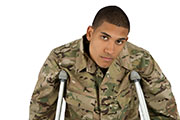- Skip Storing This Everyday Product in the Fridge Door
- Green Tea + B3 Pairing May Boost Brain Health
- Navigating Your Midlife Crisis: Embracing New Possibilities
- City Raccoons Showing Signs of Domestication
- Mapping the Exposome: Science Broadens Focus to Environmental Disease Triggers
- One Week Less on Social Media Linked to Better Mental Health
- Your Brain Changes in Stages as You Age, Study Finds
- Some Suicide Victims Show No Typical Warning Signs, Study Finds
- ByHeart Formula Faces Lawsuits After Babies Sickened With Botulism
- Switch to Vegan Diet Could Cut Your Greenhouse Gas Emissions in Half
Many U.S. Vets Suffer Chronic Pain, Take Narcotic Painkillers: Study


Nearly half of U.S. soldiers returning home are caught in the grip of chronic pain, with a substantial number of them relying on addictive narcotic painkillers to help them cope, a new study finds.
About 44 percent of the members of an Army infantry brigade reported chronic pain even three months after returning from their tour of duty in Afghanistan or Iraq, nearly double the estimate for the civilian population. Civilian chronic pain rates are about 26 percent.
Soldiers also are nearly four times more likely than civilians to use prescription narcotics to treat their pain, according to the report published online June 30 in the journal JAMA Internal Medicine. About 15 percent of soldiers in the brigade reported using narcotic painkillers within the last month, compared to 4 percent of civilians.
“War is really hard on the body,” said study author Lt. Cmdr. Robin Toblin, a clinical research psychologist at the Walter Reed Army Institute of Research in Silver Spring, Md. “People come home with a lot of injuries, and as you can imagine they experience a lot of pain. There seems to be a large unmet need of management, treatment and assessment of chronic pain.”
Combat injuries appear to be the main cause of chronic pain among returning soldiers. The study defined chronic pain as pain lasting 90 days or more. Those who have endured a combat injury are nearly three times more likely to report chronic pain and twice as likely to take narcotic painkillers, the researchers reported.
Soldiers also were twice as likely to report chronic pain if they suffer from depression or post-traumatic stress disorder.
Toblin and her colleagues collected their data in 2011, using confidential surveys filled out by almost 2,600 soldiers in the same infantry brigade.
Another expert welcomed the study.
“This gives us the first complete snapshot of an entire battalion. It really highlights the extent of the problem the Department of Defense is presented with, in terms of better managing pain,” said Dr. Wayne Jonas, a retired Army lieutenant colonel and president and CEO of Samueli Institute, a non-profit health research organization.
Among the soldiers reporting chronic pain, 48 percent said their pain had lasted a year or longer, and 55 percent said they suffered daily or constant pain.
It’s likely that soldiers’ chronic pain is undertreated, given that chronic pain is undertreated in the civilian population, said Jonas, who wrote an editorial accompanying Toblin’s study.
“In the military, pain is seen as a sign of weakness so many people don’t report it,” he said. “It’s being undertreated, and it’s being treated too often using medications that aren’t meant to be used on a long-term basis.”
Toblin and Jonas were troubled by the heavy use of narcotic painkillers, particularly since 44 percent of the soldiers reporting use of painkillers said they had little to no pain during the previous month.
“This might imply that opioids are working to mitigate pain, but it is also possible that soldiers are receiving or using these medications unnecessarily,” the researchers wrote in their report.
Military medical officials struggle to balance the need for pain management against the risks of addiction, Toblin said.
“You want to be able to treat people appropriately for their pain, but you don’t want them to become addicted,” she said.
Painkillers have become “fast food for pain management,” Jonas said. “When you need pain relief, you can throw something at it, but it’s not necessarily good for you to use them all the time.”
Jonas said the defense department has started looking into other techniques for handling pain, such as yoga, tai chi or music therapy.
“You can train people in these things, and they can learn to self-manage their pain, rather than just pop a pill,” he said.
He said the defense department is also evaluating programs that would train its medical officials in acupuncture — right down to medics in the field practicing acupuncture.
“It’s really about integration,” he said. “It’s not about avoiding drugs. It’s about more appropriate use of drugs, in conjunction with other pain management tools.”
More information
For more on chronic pain, visit the U.S. National Institutes of Health.
Source: HealthDay
Copyright © 2025 HealthDay. All rights reserved.










